| Missinaibi
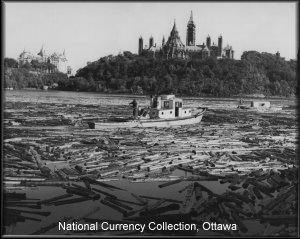 1024 pix ENLARGE 300DPI 1024 pix ENLARGE 300DPI |
|
Famous as one of the two tugs on the reverse of the last Canadian paper dollar bill.
Missinaibi [C. 190439] registered at Owen Sound; built at Owen Sound in 1952 by Russel Brothers. 38'3 x 11'5 x 4'; 14 g.t., 330 hp. Owned by Pineland Timber Co. Ltd., Sudbury, Ontario. See clipping file for pics. Canadian List of Shipping 1970: Steel tug Missinaibi [C.190439] registered at Owen Sound. Built at Owen Sound in 1952. 38'; 14 g.t. More on the Dollar Bill |
F. Loiselle clipping from newspapers.com. Mentions Dorkas and Missinaibi
 |
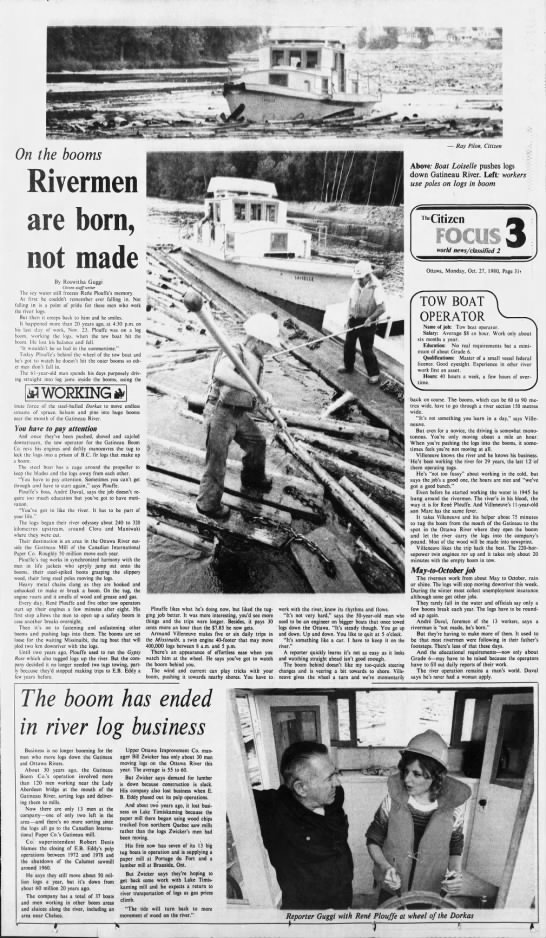
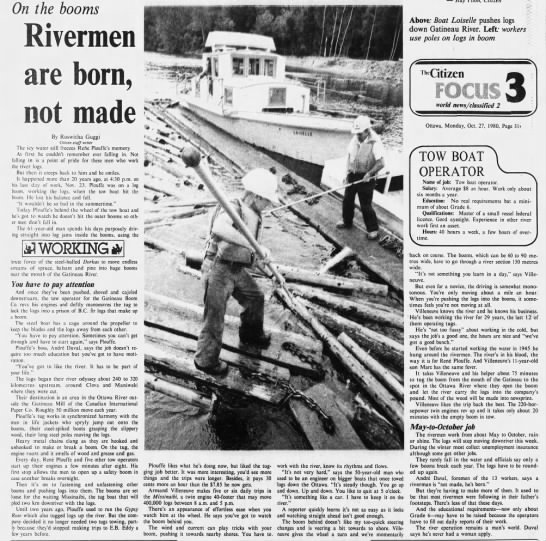
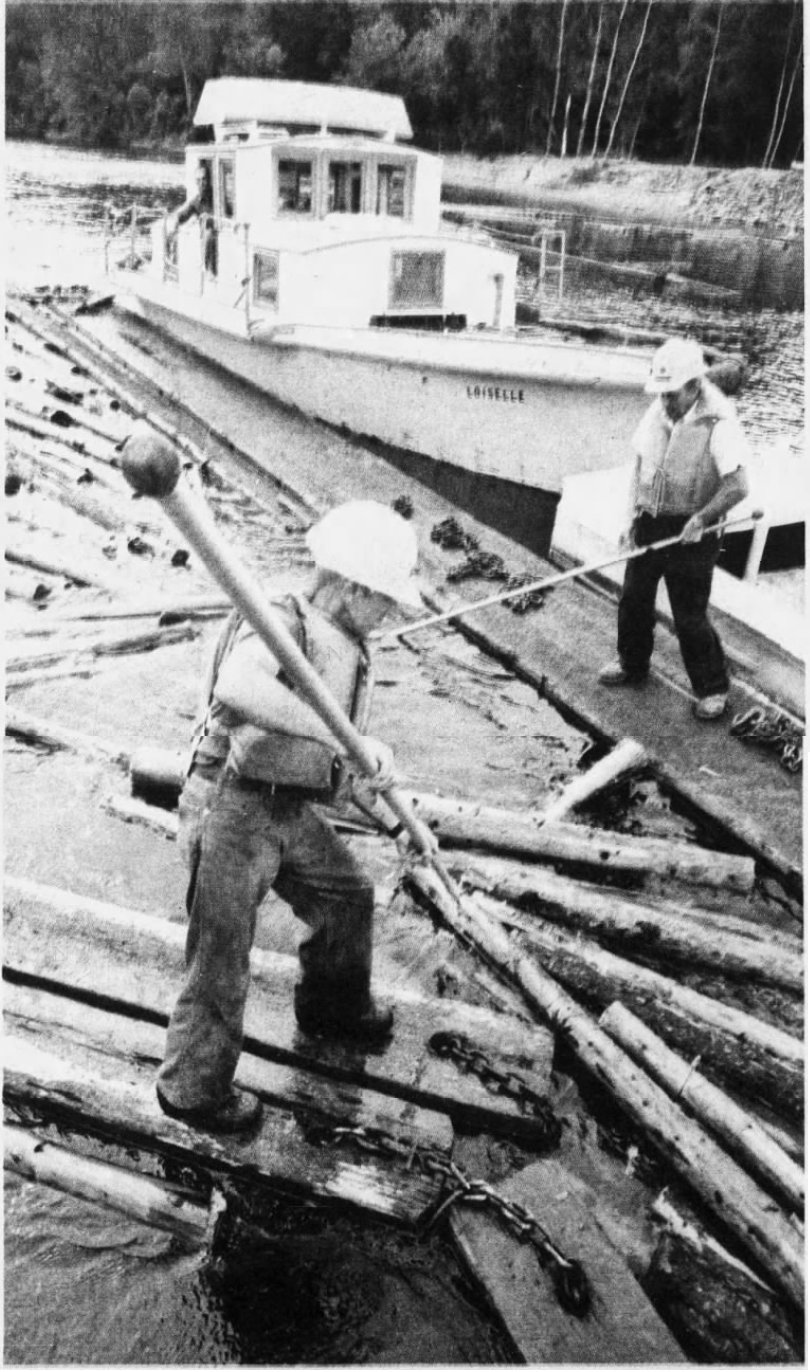
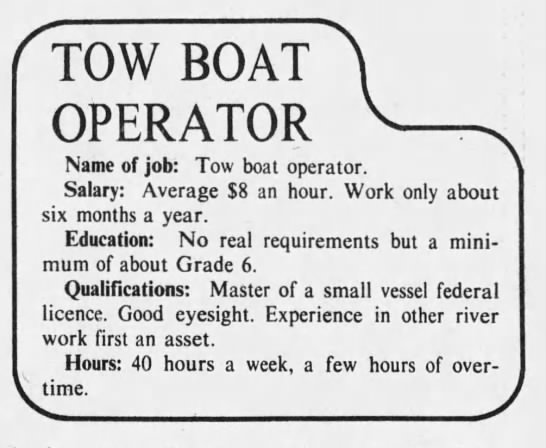
|
Mon. Oct. 27, 1980, Page 31 - The Ottawa Citizen - River Men are born, not made
By Roswitha Guggi Citizen staff writer.
The icy water still freezes Rene Plouffe's memory. At first he couldn't remember ever falling in. Not falling in is a point of pride for these men who work the river logs. But then it creeps back to him and he smiles. It happened more than 20 years ago, at 4:30 p.m. on his last day of work, Nov. 23. Plouffe was on a log boom, working the logs, when the tow boat hit the boom. He lost his balance and fell. "It wouldn't be so bad in the summertime."
Today Plouffe's behind the wheel of the tow boat and he's got to watch he doesn't hit the outer booms so other men don't fall in. The 61-year-old man spends his days purposely driving straight into log jams inside the booms, using the brute force of the steel-hulled Dorkas to move endless streams of spruce, balsam and pine into huge booms near the mouth of the Gatineau River. You have to pay attention And once they've been pushed, shoved and cajoled downstream, the tow operator for the Gatineau Boom Co. revs his engines and deftly manoeuvres the tug to lock the logs into a prison of B.C. fir logs that make up a boom.
The steel boat has a cage around the propeller to keep the blades and the logs away from each other. "You have to pay attention. Sometimes you can't get through and have to start again," says Plouffe. Plouffe's boss, Andre Duval, says the job doesn't require too much education but you've got to have motivation. "You've got to like the river. It has to be part of your life."
The logs began their river odyssey about 240 to 320 kilometres upstream, around Clova and Maniwaki where they were cut. Their destination is an area in the Ottawa River outside the Gatineau Mill of the Canadian International Paper Co. Roughly 50 million move each year. Plouffe's tug works in synchronized harmony with the men in life jackets who spryly jump out onto the booms, their steel-spiked boots grasping the slippery wood, their long steel poles moving the logs. Heavy metal chains clang as they are hooked and unhooked to make or break a boom.
On the tug, the engine roars and it smells of wood and grease and gas. Every day, Rene Plouffe and five other tow operators start up their engines a few minutes after eight. His first stop allows the men to open up a safety boom in case another breaks overnight. Then it's on to fastening and unfastening other booms and pushing logs into them. The booms are set loose for the waiting Missinaibi, the tug boat that will plod two km downriver with the logs.
Until two years ago, Plouffe used to run the Gypsy Rose which also tugged logs up the river. But the company decided it no longer needed two tugs towing, partly because they'd stopped making trips to E.B. Eddy a few years before. Plouffe likes what he's doing now, but liked the tugging job better. It was more interesting, you'd see more things and the trips were longer. Besides, it pays 30
cents more an hour than the $7.85 he now gets.
Armand Villeneuve makes five or six daily trips in the Missinaibi, a twin engine 40-footer that may move 400,000 logs between 8 a.m. and 5 p.m. There's an appearance of effortless ease when you watch him at the wheel. He says you've got to watch the boom behind you. The wind and current can play tricks with your boom, pushing it towards nearby shores. You have to work with the river, know its rhythms and flows, "It's not very hard," says the 50-year-old man who used to be an engineer on bigger boats that once towed logs down the Ottawa. "It's steady though. You go up and down. Up and down. You like to quit at 5 o'clock.
"It's something like a car. I have to keep it on the river."
A reporter quickly learns it's not as easy as it looks
and watching straight ahead isn't good enough. The boom behind doesn't like my too-quick steering changes and is veering a bit towards to shore. Villeneuve gives the wheel a turn and we're momentarily back on course. The booms, which can be 60 to 90 metres wide, have to go through a river section 150 metres wide.
"It's not something you learn in a day," says Villeneuve. But even for a novice, the driving is somewhat monotonous. You're only moving about a mile an hour. When you're pushing the logs into the booms, it sometimes feels you're not moving at all.
Villeneuve knows the river and he knows his business. He's been working the river for 29 years, the last 12 of them operating tugs. He's "not too fussy" about working in the cold, but says the job's a good one, the hours are nice and "we've got a good bunch."
Even before he started working the water in 1945 he hung around the rivermen. The river's in his blood, the way it is for Rene Plouffe. And Villeneuve's 11-year-old son Marc has the same fever. It takes Villeneuve and his helper about 75 minutes to tug the boom from the mouth of the Gatineau to the spot in the Ottawa River where they open the boom and let the river carry the logs into the company's pound. Most of the wood will be made into newsprint.
Villeneuve likes the trip back the best. The 220-horsepower twin engines rev up and it takes only about 20 minutes with the empty boom in tow.
May-to-October job
The rivermen work from about May to October, rain or shine. The logs will stop moving downriver this week. During the winter most collect unemployment insurance, although some get other jobs. They rarely fall in the water and officials say only a few booms break each year. The logs have to be rounded up again. Andre Duval, foremen of the 13 workers, says a riverman is "not made, he's born."
But they're having to make more of them. It used to be that most rivermen were following in their father's footsteps. There's less of that these days. And the educational requirements now only about Grade 6 may have to be raised because the operators have to fill out daily reports of their work. The river operation remains a man's world. Duval says he's never had a woman apply.
TOW BOAT OPERATOR Name of job: Tow boat operator Salary: Average $8 an hour. Work only about six months a year. Education: No real requirements but a minimum of about Grade 6. Qualifications: Master of a small vessel federal licence. Good eyesight. Experience in other river work first an asset. Hours: 40 hours a week, a few hours of overtime.
|
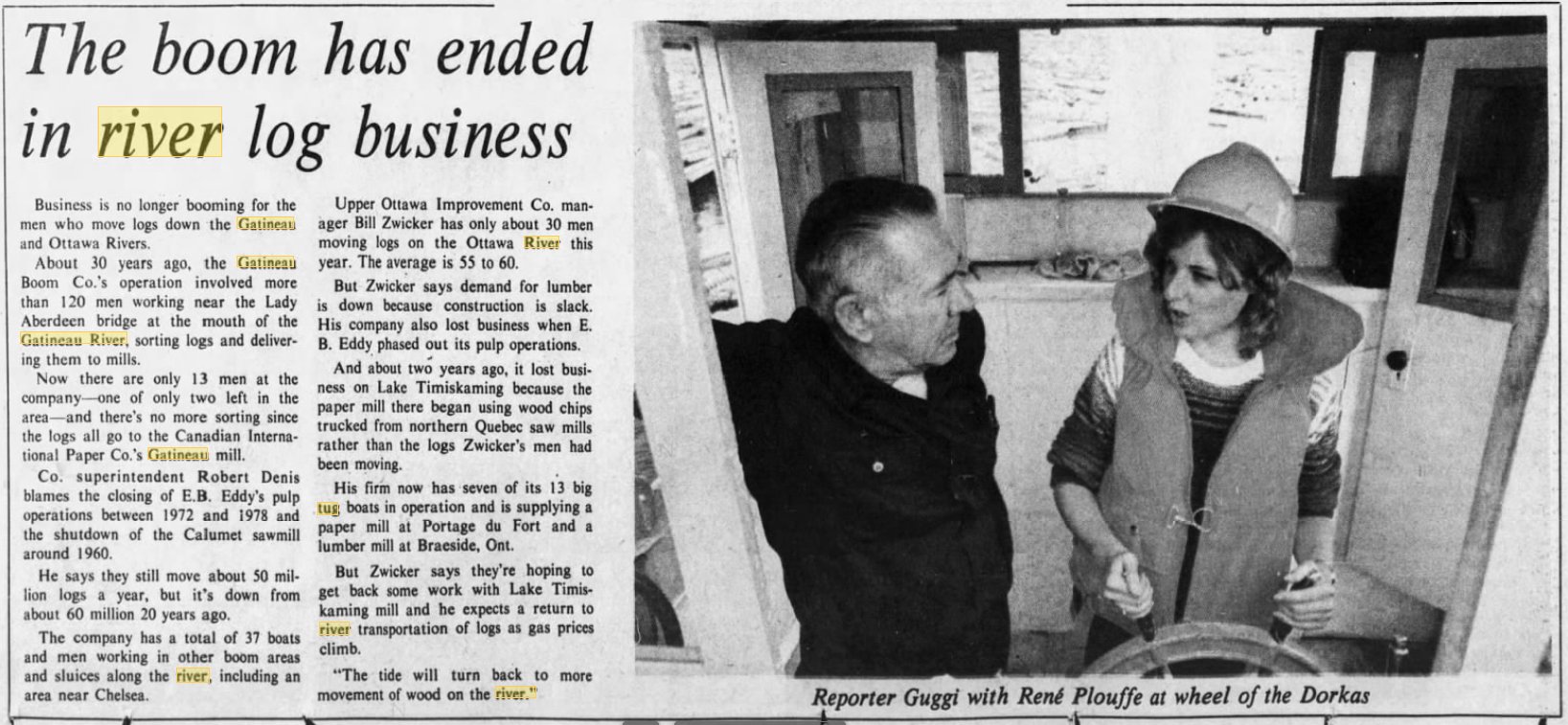 |
Mon. Oct. 27, 1980, Page 31 - The Ottawa Citizen - The boom has ended in river log business
Business is no longer booming for the men who move logs down the Gatineau and Ottawa Rivers. About 30 years ago, the Gatineau Boom Co.'s operation involved more than 120 men working near the Lady Aberdeen bridge at the mouth of the Gatineau River, sorting logs and delivering them to mills. Now there are only 13 men at the company one of only two left in the area and there's no more sorting since the logs all go to the Canadian International Paper Co.'s Gatineau mill.
Co. superintendent Robert Denis blames the closing of E.B. Eddy's pulp operations between 1972 and 1978 and the shutdown of the Calumet sawmill around 1960. He says they still move about 50 million logs a year, but it's down from about 60 million 20 years ago. The company has a total of 37 boats and men working in other boom areas and sluices along the river, including an area near Chelsea.
Upper Ottawa Improvement Co. manager Bill Zwicker has only about 30 men moving logs on the Ottawa River this year. The average is 55 to 60. But Zwicker says demand for lumber is down because construction is slack. His company also lost business when E. B. Eddy phased out its pulp operations. And about two years ago, it lost business on Lake Timiskaming because the paper mill there began using wood chips trucked from northern Quebec saw mills rather than the logs Zwicker's men had been moving.
His firm now has seven of its 13 big tug boats in operation and is supplying a paper mill at Portage du Fort and a lumber mill at Braeside, Ont. But Zwicker says they're hoping to get back some work with Lake Timiskaming mill and he expects a return to river transportation of logs as gas prices climb. "The tide will turn back to more movement of wood on the river."
|
Missinaibi clippings from newspapers.com.
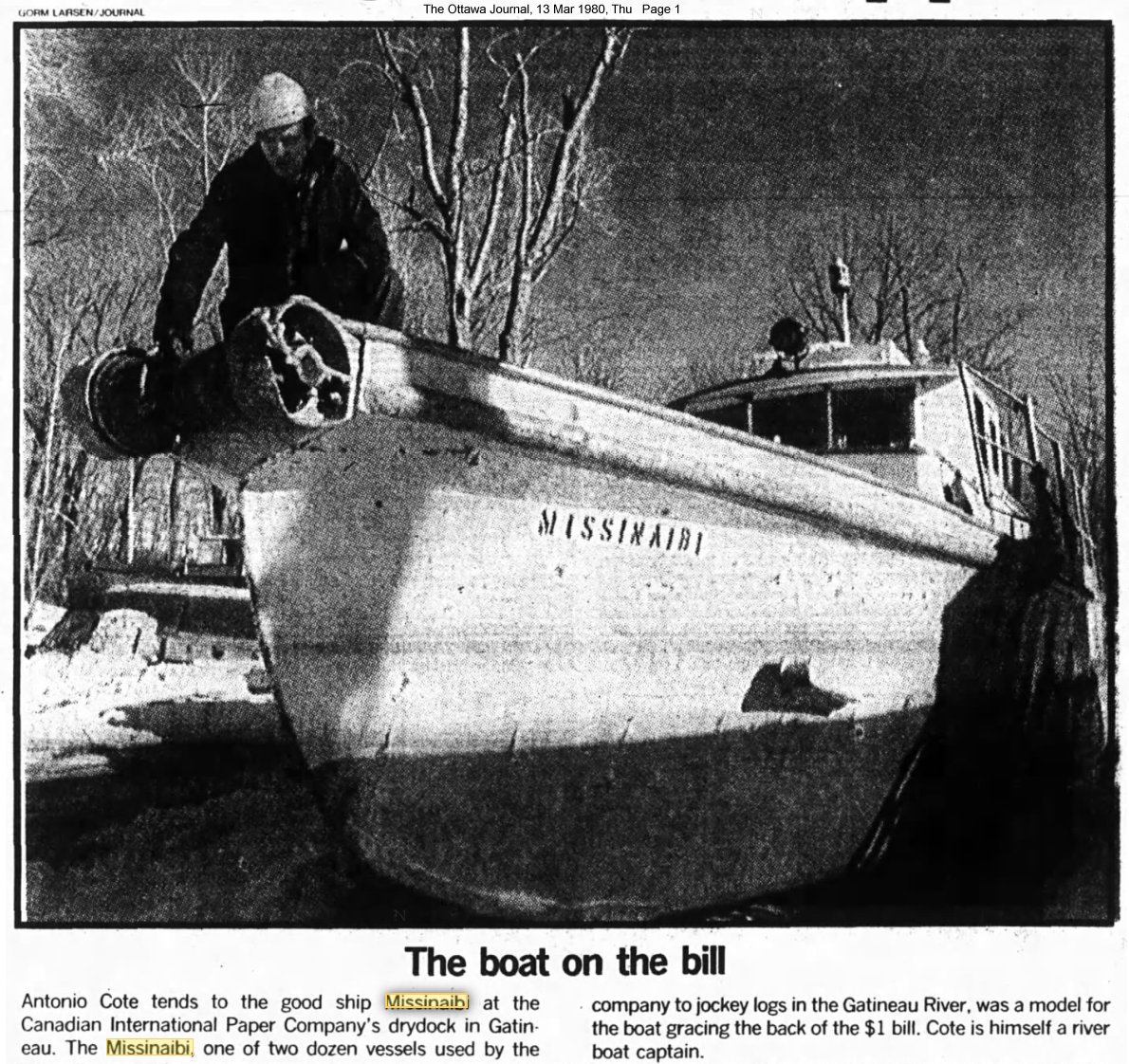 |
Thurs. March 13, 1980, Page 1 - The Ottawa Journal: The boat on the bill.
Antonio Cote tends to the good ship Missinaibi at the Canadian International Paper Company's drydock in Gatineau. The Missinaibi, one of two dozen vessels used by the company to jockey logs in the Gatineau River, was a model for the boat gracing the back of the $1 bill. Cote is himself a river boat captain.
|
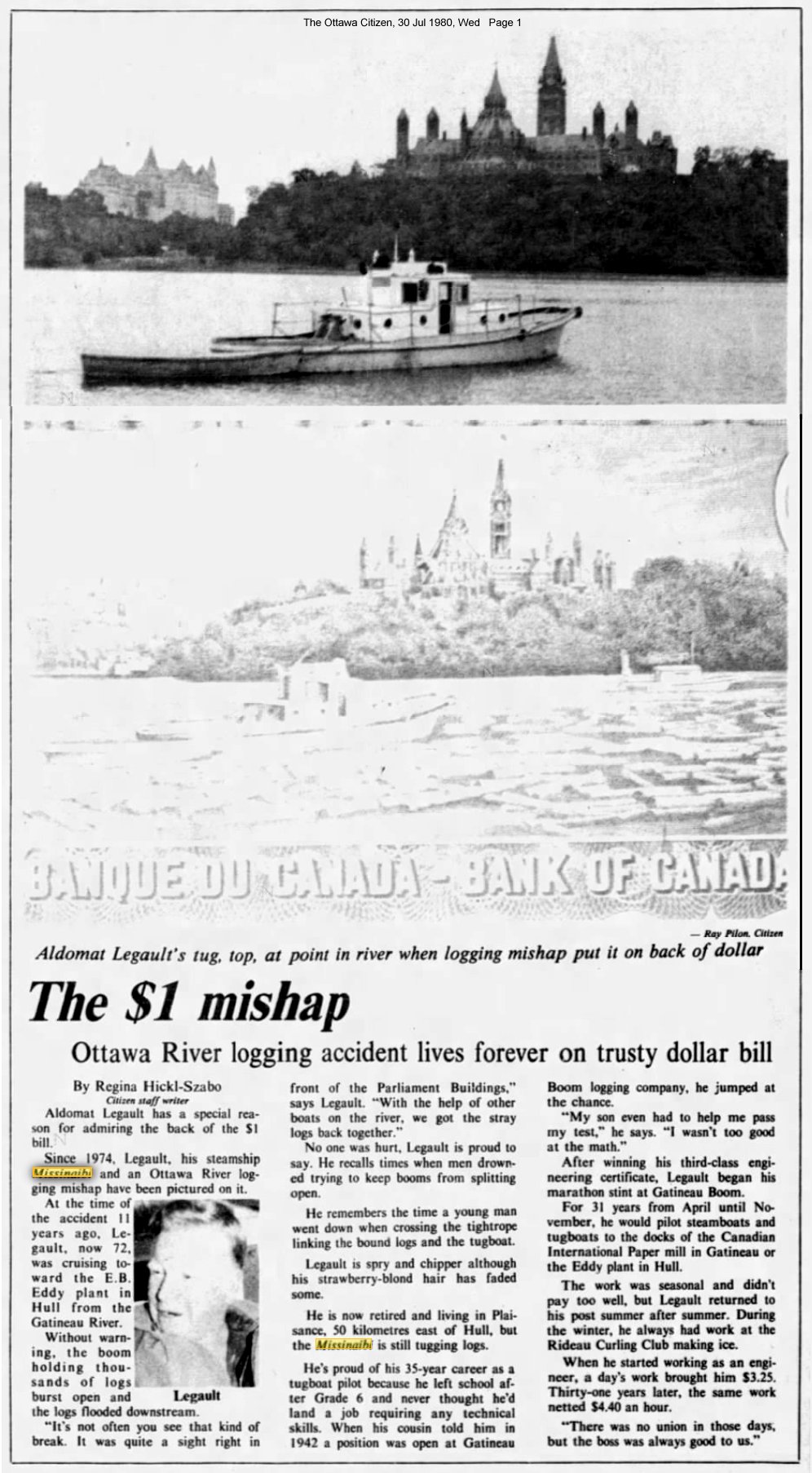 |
Wed. July 30, 1980, Page 1 - The Ottawa Citizen: The $1 mishap Ottawa River logging accident lives forever on trusty dollar bill.
By Regina Hickl-Szabo Citizen staff writer. Aldomat Legault has a special reason for admiring the back of the $1 bill. Since 1974, Legault, his steamship Missinaibi and an Ottawa River logging mishap have been pictured on it. At the time of the accident 11 years ago, Legault, now 72, was cruising toward the E. B. Eddy plant in Hull from the Gatineau River. Without warning, the boom holding thousands of logs burst open and the logs flooded downstream.
"It's not often you see that kind of break. It was quite a sight right in front of the Parliament Buildings," says Legault. "With the help of other boats on the river, we got the stray logs back together." No one was hurt, Legault is proud to say. He recalls times when men drowned trying to keep booms from splitting open. He remembers the time a young man went down when crossing the tightrope linking the bound logs and the tugboat.
Legault is spry and chipper although his strawberry-blond hair has faded some. He is now retired and living in Plaisance, 50 kilometres east of Hull, but the Missinaibi is still tugging logs. He's proud of his 35-year career as a tugboat pilot because he left school after Grade 6 and never thought he'd land a job requiring any technical skills. When his cousin told him in 1942 a position was open at Gatineau Boom logging company, he jumped at the chance.
"My son even had to help me pass my test," he says. "I wasn't too good at the math." After winning his third-class engineering certificate, Legault began his marathon stint at Gatineau Boom. For 31 years from April until November, he would pilot steamboats and tugboats to the docks of the Canadian International Paper mill in Gatineau or the Eddy plant in Hull. The work was seasonal and didn't pay too well, but Legault returned to his post summer after summer. During the winter, he always had work at the Rideau Curling Club making ice. When he started working as an engineer, a day's work brought him $3.25. Thirty-one years later, the same work netted $4.40 an hour. There was no union in those days, but the boss was always good to us."
|
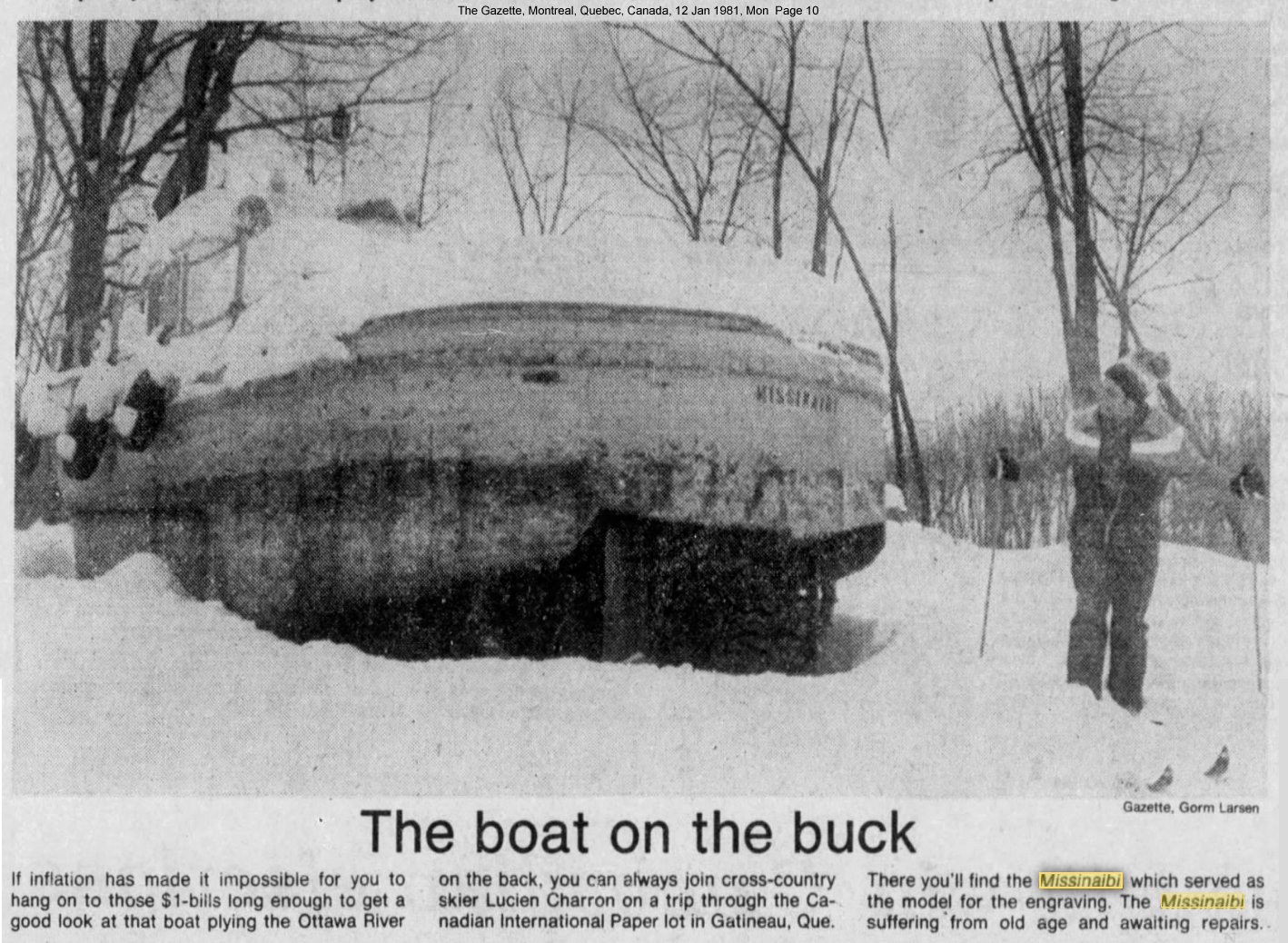 |
Mon. 12 Jan 1981, Page 10 - The Montreal Gazette: The boat on the buck
If inflation has made it impossible for you to hang on to those $1-bills long enough to get a good look at that boat plying the Ottawa River on the back, you can always join cross-country skier Lucien Charron on a trip through the Canadian International Paper lot in Gatineau, Que. There you'll find the Missinaibi, which served as the model for the engraving. The Missinaibi is suffering from old age and awaiting repairs.
|
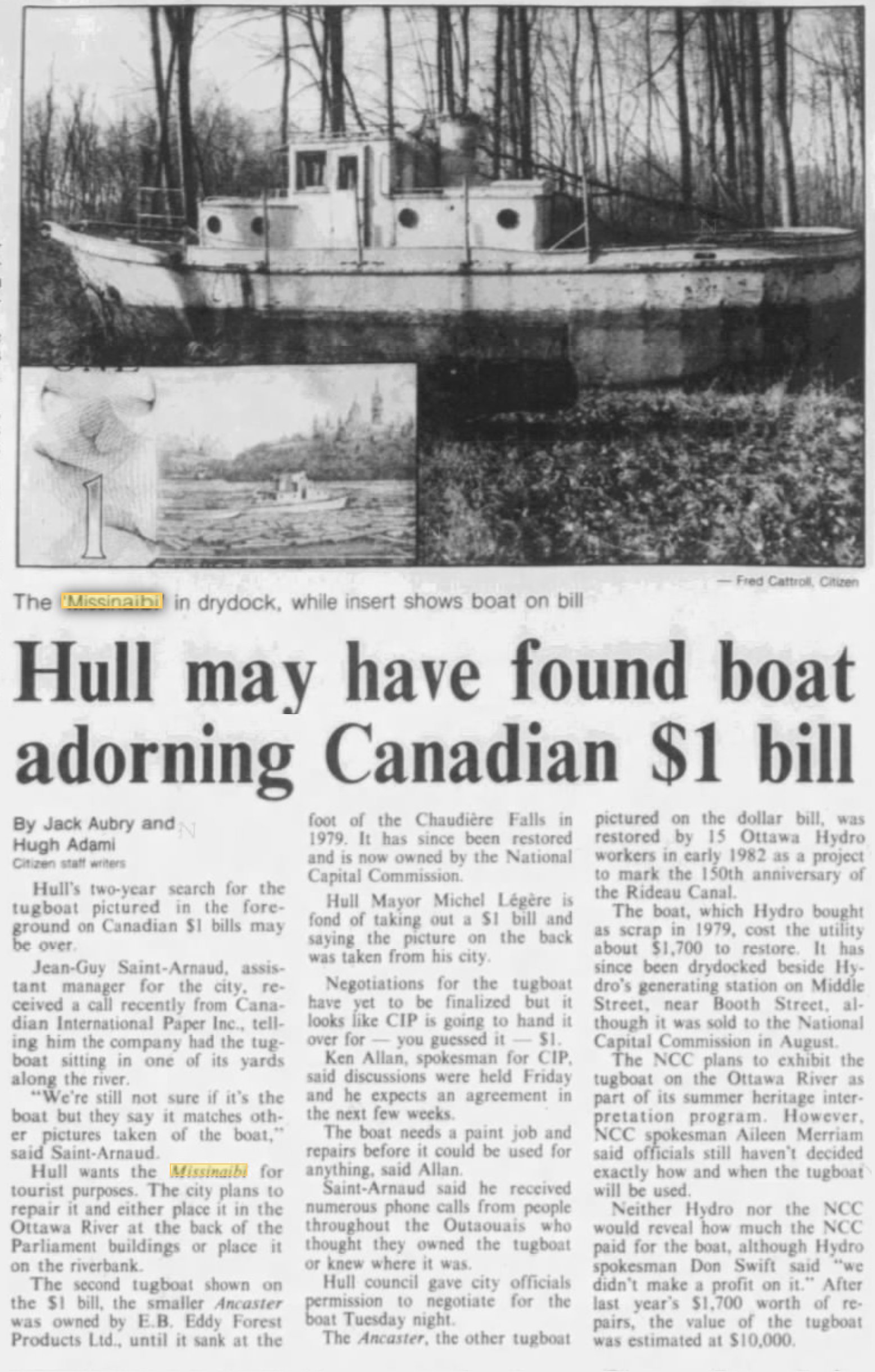 |
Wed., Nov. 23, 1983, Page 2 - The Ottawa Citizen: Hull may have found boat adorning Canadian $1 bill.
By Jack Aubry and Hugh Adami Citizen staff writers.
Hull's two-year search for the tugboat pictured in the foreground on Canadian $1 bills may be over. Jean-Guy Saint-Arnaud, assistant manager for the city, received a call recently from Canadian International Paper Inc., telling him the company had the tugboat sitting in one of its yards along the river. "We're still not sure if it's the boat but they say it matches other pictures taken of the boat," said Saint-Arnaud.
Hull wants the Missinaibi for tourist purposes. The city plans to repair it and either place it in the Ottawa River at the back of the Parliament buildings or place it on the riverbank. The second tugboat shown on the $1 bill, the smaller Ancaster was owned by E.B. Eddy Forest Products Ltd., until it sank at the foot of the Chaudiere Falls in 1979. It has since been restored and is now owned by the National Capital Commission.
Hull Mayor Michel Legere is fond of taking out a $1 bill and saying the picture on the back was taken from his city. Negotiations for the tugboat have yet to be finalized but it looks like CIP is going to hand it over for you guessed it - $1. Ken Allan, spokesman for CIP, said discussions were held Friday and he expects an agreement in the next few weeks.
The boat needs a paint job and repairs before it could be used for anything, said Allan. Saint-Arnaud said he received numerous phone calls from people throughout the Outaouais who thought they owned the tugboat or knew where it was. Hull council gave city officials permission to negotiate for the boat Tuesday night.
The Ancaster, the other tugboat pictured on the dollar bill, was restored by 15 Ottawa Hydro workers in early 1982 as a project to mark the 150th anniversary of the Rideau Canal. The boat, which Hydro bought as scrap in 1979, cost the utility about $1,700 to restore. It has since been drydocked beside Hydro's generating station on Middle Street, near Booth Street, although it was sold to the National Capital Commission in August.
The NCC plans to exhibit the tugboat on the Ottawa River as part of its summer heritage interpretation program. However, NCC spokesman Aileen Merriam said officials still haven't decided exactly how and when the tugboat will be used. Neither Hydro nor the NCC would reveal how much the NCC paid for the boat, although Hydro spokesman Don Swift said "we didn't make a profit on it." After last year's $1,700 worth of repairs, the value of the tugboat was estimated at $10,000.
|
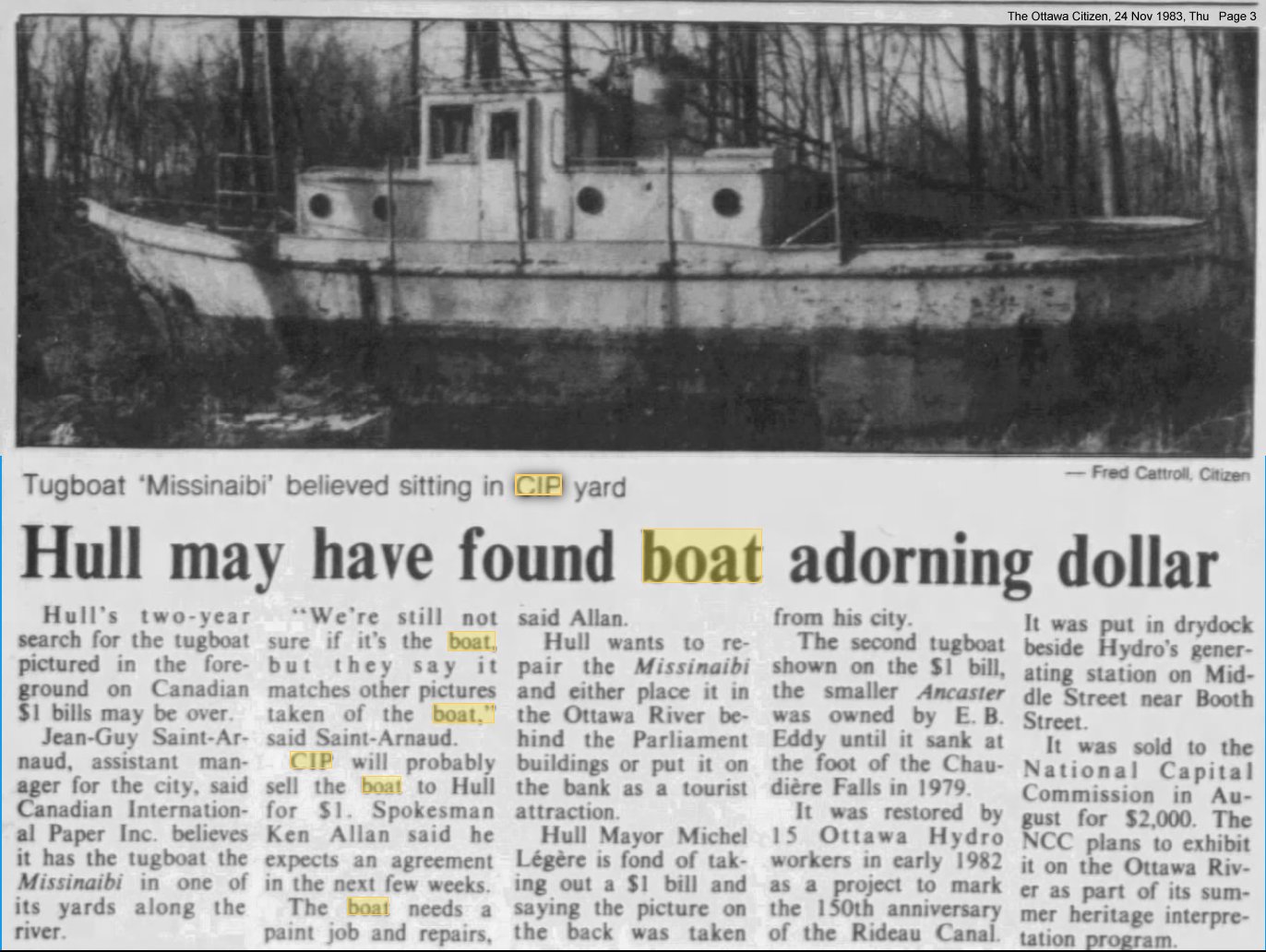 |
Thurs. 24 Nov 1983, Page 3 - The Ottawa Citizen: Tugboat Missinaibi believed sitting in CIP yard. Hull may have found boat adorning dollar.
Hull's two-year search for the tugboat pictured in the foreground on Canadian $1 bills may be over. Jean-Guy Saint-Arnaud, assistant manager for the city, said Canadian International Paper Inc. believes it has the tugboat the Missinaibi in one of its yards along the river. "We're still not sure if it's the boat, but they say it matches other pictures taken of the boat," said Saint-Arnaud.
CIP will probably sell the boat to Hull for $1. Spokesman Ken Allan said he expects an agreement in the next few weeks. The boat needs a paint job and repairs, said Allan. Hull wants to repair the Missinaibi and either place it in the Ottawa River behind the Parliament buildings or put it on the bank as a tourist attraction.
Hull Mayor Michel Legere is fond of taking out a $1 bill and saying the picture on the back was taken from his city. The second tugboat shown on the $1 bill, the smaller Ancaster was owned by E. B. Eddy until it sank at the foot of the Chaudiere Falls in 1979. It was restored by 15 Ottawa Hydro workers in early 1982 as a project to mark the 150th anniversary of the Rideau Canal. It was put in drydock beside Hydro's generating station on Middle Street near Booth Street. It was sold to the National Capital Commission in August for $2,000. The NCC plans to exhibit it on the Ottawa River as part of its summer heritage interpretation program.
|
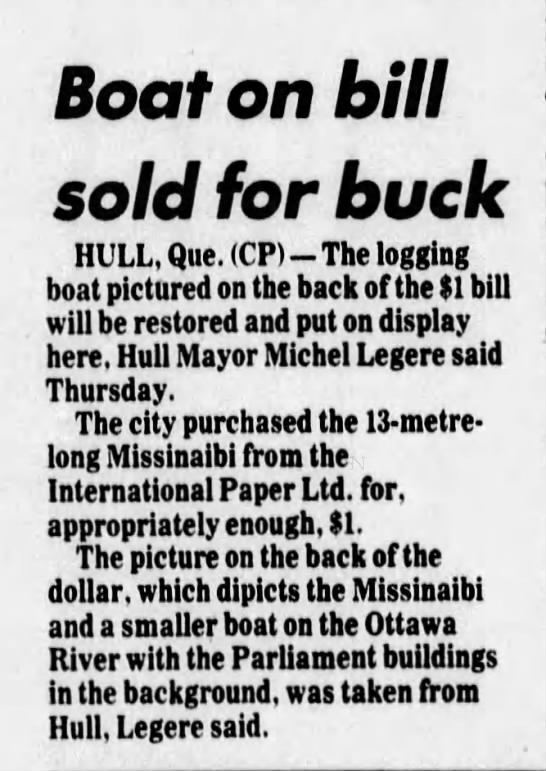 |
Fri. July 6, 1984, Page 13 - The Vancouver Sun: Boat on bill sold for buck
HULL, Que. (CP) - The logging boat pictured on the back of the $1 bill will be restored and put on display here, Hull Mayor Michel Legere said Thursday. The city purchased the 13 metre long Missinaibi from the International Paper Ltd. for, appropriately enough, $1. The picture on the back of the dollar, which dipicts the Missinaibi and a smaller boat on the Ottawa River with the Parliament buildings in the background, was taken from Hull, Legere said.
|
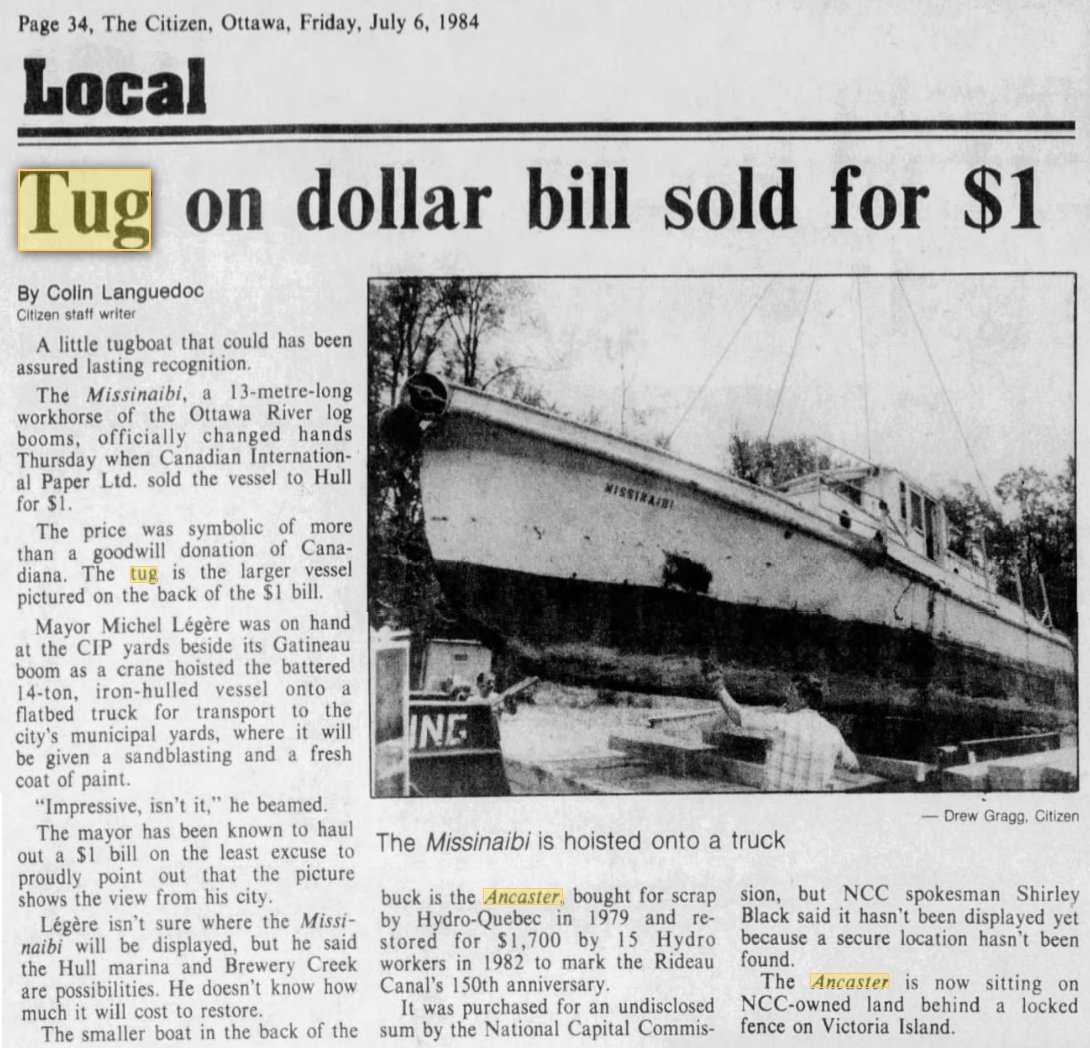 |
Fri. July 6, 1984, Page 34 - The Ottawa Citizen: Tug on dollar bill sold for $1
A little tugboat that could has been assured lasting recognition. The Missinaibi, a 13-metre-long workhorse of the Ottawa River log booms, officially changed hands Thursday when Canadian International Paper Ltd. sold the vessel to Hull for $1. The price was symbolic of more than a goodwill donation of Canadiana.
The tug is the larger vessel pictured on the back of the $1 bill. Mayor Michel Legere was on hand at the CIP yards beside its Gatineau boom as a crane hoisted the battered 14-ton, iron-hulled vessel onto a flatbed truck for transport to the city's municipal yards, where it will be given a sandblasting and a fresh coat of paint.
"Impressive, isn't it," he beamed. The mayor has been known to haul out a $1 bill on the least excuse to proudly point out that the picture shows the view from his city. Legere isn't sure where the Missinaibi will be displayed, but he said the Hull marina and Brewery Creek are possibilities. He doesn't know how much it will cost to restore. The smaller boat in the back of the buck is the Ancaster, bought for scrap by Hydro-Quebec in 1979 and restored for $1,700 by 15 Hydro workers in 1982 to mark the Rideau Canal's 150th anniversary. It was purchased for an undisclosed sum by the National Capital Commis sion, but NCC spokesman Shirley Black said it hasn't been displayed yet because a secure location hasn't been found. The Ancaster is now sitting on NCC-owned land behind a locked fence on Victoria Island.
|
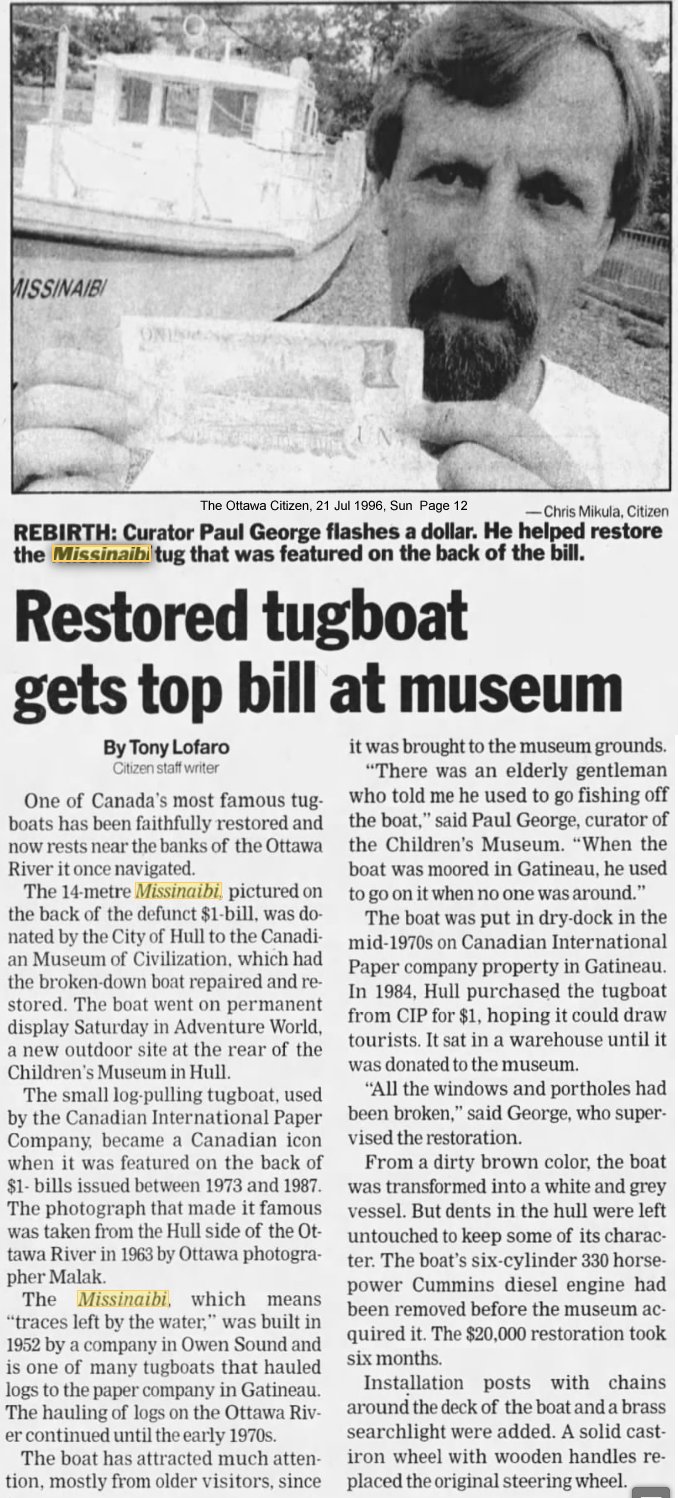 |
Sun, 21 Jul, 1996, Page 12 - The Ottawa Citizen: Restored tugboat gets top bill at museum
By Tony Lofaro Citizen staff writer. One of Canada's most famous tugboats has been faithfully restored and now rests near the banks of the Ottawa River it once navigated. The 14-metre Missinaibi, pictured on the back of the defunct $l-bill, was donated by the City of Hull to the Canadian Museum of Civilization, which had the broken-down boat repaired and restored.
The boat went on permanent display Saturday in Adventure World, a new outdoor site at the rear of the Children's Museum in Hull. The small log-pulling tugboat, used by the Canadian International Paper Company became a Canadian icon when it was featured on the back of $1 bills issued between 1973 and 1987. The photograph that made it famous was taken from the Hull side of the Ottawa River in 1963 by Ottawa photographer Malak.
The Missinaibi, which means "traces left by the water," was built in 1952 by a company in Owen Sound and is one of many tugboats that hauled logs to the paper company in Gatineau. The hauling of logs on the Ottawa River continued until the early 1970s. The boat has attracted much attention, mostly from older visitors, since it was brought to the museum grounds.
"There was an elderly gentleman who told me he used to go fishing off the boat," said Paul George, curator of the Children's Museum. "When the boat was moored in Gatineau, he used to go on it when no one was around."
The boat was put in dry-dock in the mid-1970s on Canadian International Paper company property in Gatineau. In 1984, Hull purchased the tugboat from CIP for $1, hoping it could draw tourists. It sat in a warehouse until it was donated to the museum. "All the windows and portholes had been broken," said George, who supervised the restoration.
From a dirty brown color, the boat was transformed into a white and grey vessel. But dents in the hull were left untouched to keep some of its character. The boat's six-cylinder 330 horsepower Cummins diesel engine had been removed before the museum acquired it. The $20,000 restoration took six months. Installation posts with chains around the deck of the boat and a brass searchlight were added. A solid cast-iron wheel with wooden handles replaced the original steering wheel.
|
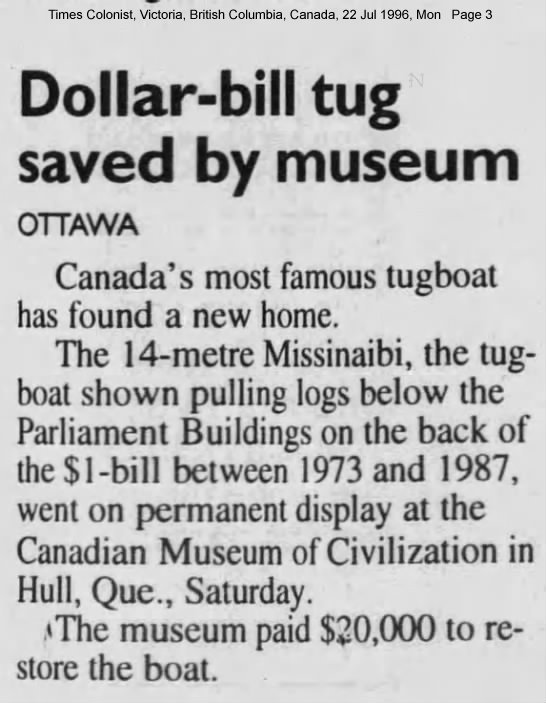 |
Mon. July 22, 1996, Page 3 - Times Colonist: Dollar-bill tug saved by museum.
OTTAWA Canada's most famous tugboat has found a new home. The 14-metre Missinaibi, the tugboat shown pulling logs below the Parliament Buildings on the back of the $l-bill between 1973 and 1987, went on permanent display at the Canadian Museum of Civilization in Hull, Que., Saturday. The museum paid $20,000 to restore the boat.
|
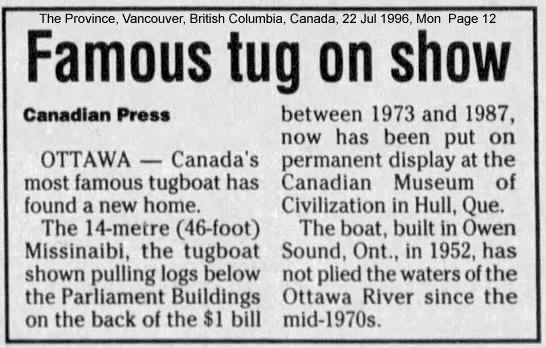 |
Mon. July 22, 1996, Page 12 - The Province: Famous tug on show
Canadian Press OTTAWA Canada's most famous tugboat has found a new home. The 14-metre (46-foot) Missinaibi, the tugboat shown pulling logs below the Parliament Buildings on the back of the $1 bill between 1973 and 1987, now has been put on permanent display at the Canadian Museum of Civilization in Hull, Que. The boat, built in Owen Sound, Ont., in 1952, has not plied the waters of the Ottawa River since the mid-1970s.
|
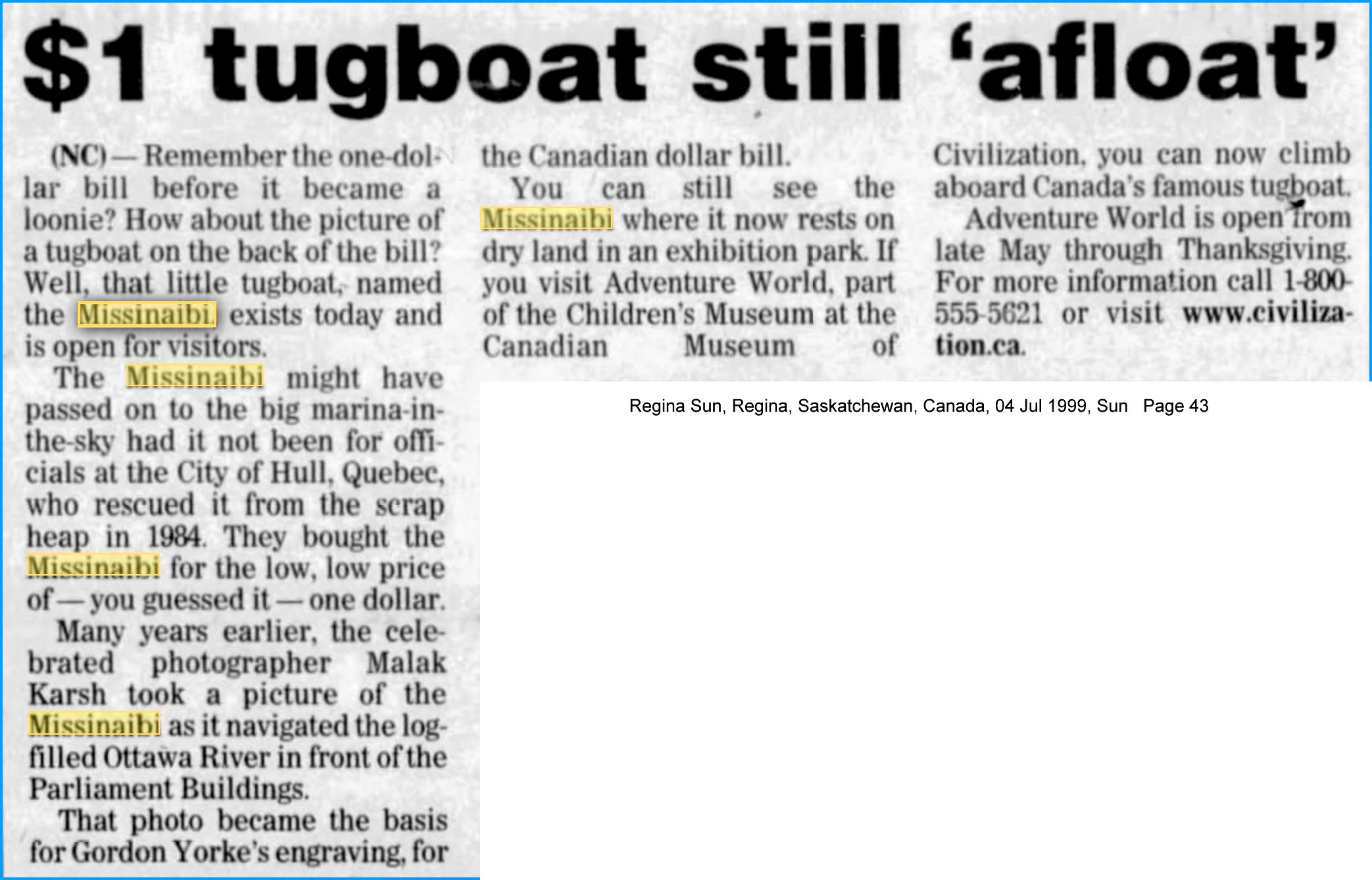 |
Sun. July 4, 1999, Page 43 - Regina Sun: $1 tugboat still "afloat".
Remember the one-dollar bill before it became a loonie? How about the picture of a tugboat on the back of the bill? Well, that little tugboat, named the Missinaibi, exists today and is open for visitors. The Missinaibi might have passed on to the big marina-in-the-sky had it not been for officials at the City of Hull, Quebec, who rescued it from the scrap heap in 1984.
They bought the Missinaibi for the low, low price of, you guessed it, one dollar. Many years earlier, the celebrated photographer Malak Karsh took a picture of the Missinaibi as it navigated the log-filled Ottawa River in front of the Parliament Buildings. That photo became the basis for Gordon Yorke's engraving, for the Canadian dollar bill.
You can still see the Missinaibi where it now rests on dry land in an exhibition park. If you visit Adventure World, part of the Children's Museum at the Canadian Museum of Civilization, you can now climb aboard Canadas famous tugboat. Adventure World is open from late May through Thanksgiving. For more information call 1-800-555-5021 or visit www.civilization.ca.
|

 |
Sat., July 28, 2001, Page 23 - The Ottawa Citizen: Captain says goodbye to the river.
Andre Duval piloted the Missinaibi, the tugboat that graced the back of more than 3.4 billion $1 banknotes. Mr. Duval will retire next week, after 55 years of working on the Ottawa River hauling logs. 'It was a great time,' says Mr. Duval.
Andre Duval's tugboat was once on the back of the $ 1 bill; now it's ashore. As of next week, so is its captain, writes Melanie Brooks. Andre Duval pulls an old $i bill out of his wallet, and points to the back of the crumpled paper, at the picture of a tugboat hauling logs on the Ottawa River.
Mr. Duval piloted that boat, the Missinaibi, in 1964. Mr. Duval will retire next week, after 55 years of working on the river. He started working in the golden age of the lumberjack, when the Canadian International Paper Company still transported logs by floating them down the river. He was 16, and he would retrieve the logs that strayed from the massive log floats that were being led by the tugboats down the river.
"It was a great time," said Mr. Duval, 70. "I love working on the river. And the sight of the logs was just amazing." It was this sight that attracted photographer Malak Karsh. He was taking photos at the time for the Canadian Pulp and Paper Association, and he snapped the Missinaibi from the deck of another tugboat in 1963. "The boat and the logs were at the bottom of Parliament Buildings on the Ottawa River. It was perfect," said Mr. Karsh. Workers at the Bank of Canada saw the photo, and paid Mr. Karsh $1,000 to use it on the new $1 bills.
The next year, Mr. Duval signed on as captain of the Missinaibi "The boss said to me, Do you want to work on a bigger boat?' I said, 'Oh, yeah.' Everybody wanted to drive a bigger boat," he said. "Although I wasn't officially a captain. You didn't need a licence to drive a boat in those days."
Mr. Duval worked on the Missinaibi for only a year, but it was an honour, he said. It was the year after Mr. Karsh's famous photograph, and everyone in the company was talking about it But Mr. Duval moved on the next season; he wanted an even bigger boat. By tugboat standards, the Missinaibi, built in 1952, was small. Mr. Duval worked on several different tugboats, and helped people out when he could, hauling old wrecks up from the bottom of the river. He even had a part of Kettle Island named after him: Pointe Duval.
Meanwhile, the Missinaibi was getting old, and CIP retired it in the mid-70s. In 1984, the company sold it to the City of Hull for a token $l Mr. Duval was there for the sale, and said the city didn't get the whole boat. "I still have the original wheel in my basement," he said, chuckling. Mr. Duval retired from CIP in 1990, but continued working at Paul's Boat Line, taking tourists along the river on the Paula D.
In 1963, workers at the Bank of Canada saw the above photo and paid Malak Karsh $1,000 so the bank could use the image on the new $1 bills, below.
The Missinaibi now sits in the children's museum at the Canadian Museum of Civilization, right on the spot where the logging companies used to stack the huge logs they had towed, tied together in massive booms down the river. More than 3.4 billion $1 bills featuring the little tugboat were printed between 1974 and 1989, when the bill was replaced by the loonie. But Mr. Duval still fondly remembers seeing his little tugboat every time he pulled out a bill. "The $1 bill is my favourite," he said. "It's easier to put in your wallet"
|
The MISSINAIBI at Hull, Qc on Sept. 26, 1985 after its purchase from CIP in 1984 by the City of Hull and before her transfer to the Canadian Museum of Civilization. Photo by George Ayoub, Rene Beauchamp collection.
Missinaibi at her final berth, c. 1997. Photo courtesy Gerry Ouderkirk.
RBF notes: On display (Hull, QC April 6, 2004).
Sept. 26, 2005 photos by Steve Briggs. Click photos for 1024 pixels wide.
Russel Brothers built Warping Tug Missinaibi
(as featured on the Canadian $1 bill)
The small tugboat called the Missinaibi "logged" a lot of miles on the Ottawa River before it reached its final harbour at the Canadian Museum of Civilization. A notable symbol of Canada's early industrial era, it will now live on as a tangible witness to its past history for future generations.
 The Missinaibi about to dock at it's final pier at the Ottawa The Missinaibi about to dock at it's final pier at the Ottawa
Canadian Children's Museum playground, 1996. | |
The Missinaibi was one of hundreds of tugboats built by Russel-Hipwell Engines Ltd. of Owen Sound, Ontario. The company specialized in the construction of small boats for industrial use -- coastal vessels, tugboats, barges, etc. -- and in 1952 it built the Missinaibi, whose name means "traces left by the water". The Missinaibi, a 14-ton tugboat measuring 14 metres long, was driven by a six-cylinder Cummins diesel engine that generated 330 horsepower and ran two propellers. The tugboat was first purchased by the Pineland Timber Company, and was sold in 1956 to the Gatineau-based Canadian International Paper Company, which later became the CIP.
The Missinaibi began its career in the Outaouais region, navigating the Ottawa River as it hauled log-floats to the paper company in Gatineau. Its home port was near Verdun Street in Hull, and then in Gatineau's Fournier Bay. The Missinaibi would also travel as far as Hawkesbury and Carillon, in the days before the Carillon dam was built. For major repairs, it would go downriver to the shipyard in Sorel. The boat was retired in the mid-1970s, and put into dry-dock on CIP property near the Notre-Dame Cemetery in Gatineau.
The little tugboat would probably have passed into oblivion and been sent to the scrapyard like so many others, had it not become the illustration on the back of the Canadian one-dollar bill. In 1963, celebrated Ottawa photographer Malak took a picture of the Missinaibi in its natural element: navigating the log-filled Ottawa River against the background of the Parliament Buildings. This photograph was to play a major role in deciding the tugboat's fate when the government decided to change the design of Canadian paper currency in a move to tighten security and prevent counterfeiting. The new notes included security innovations such as multicolor printing, along with familiar design elements from the previous bills to facilitate public recognition.
It was thus decided to use panoramas once again of representative regions of the country, based on photographs from various sources, to create a single landscape. Each scene had to be suitable for engraving and major print-runs. Modifications were thus made to the original photographs, and none of the illustrations which appeared on our paper currency was an exact replica of the original photo.
In a 1989 article in Le Droit, one of the last tow-pilots of the Missinaibi, Aldoma Legault, who died in 1994, recounted taking the ship's helm in 1969 and 1971 for the photo shoots. No pilot is visible on the dollar bill, however -- a creative liberty taken by designers in their adaptation of the original shots. n.b. - M. Legault was remembering falsely. The original Malak photo was taken in 1963, was not posed, and shows no pilot on the Missinaibi, only a man with a pole on the afterdeck. For counterpoint, here's a 1981 article about M. Legault describing the accident as occurring in 1970, wherein he also admits "I wasn't too good at the math". - ed.
| |
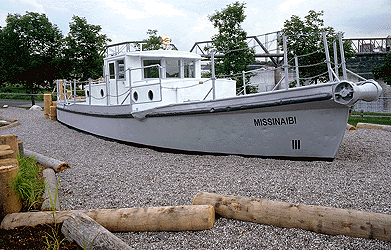 The Missinaibi as it is today. Note front winch roller. The Missinaibi as it is today. Note front winch roller.
|
The engraving on the back of the one-dollar bill featuring the Missinaibi is the work of Gordon Yorke of the British American Bank Note Company. The overall design of the one-dollar bill is the result of the joint efforts of the Bank of Canada, the Canadian Bank Note Company, British American Bank Note, and Thomas De La Rue and Co. Ltd.
About 3.4 billion one-dollar bills were printed between June 3, 1974 and June 30, 1989, when the paper dollar was discontinued.
Despite its sudden and unexpected fame, the Missinaibi did not escape the scrapheap after log-floating ceased on the Ottawa River. The City of Hull noticed the abandoned tug, however, and municipal authorities, thinking it could be used as a tourist attraction, purchased it from the CIP in 1984 for the nominal price of one dollar. The Missinaibi was stored in a municipal warehouse for some time, until the municipality decided to donate it to the Canadian Museum of Civilization, which will restore the tugboat to its rightful glory after years of neglect.
|